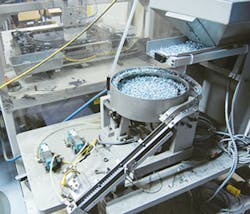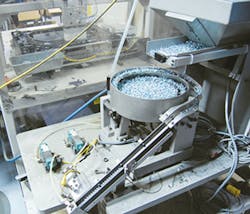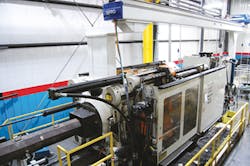Revere constantly adapting for diverse markets
Revere Plastics Systems LLC, Clyde, Ohio, is a veritable playground for any plastics industry engineer who wants to witness the range of technologies that make commercial-grade and household appliances function.
Revere's clients include GE, Whirlpool and Maytag, just to name a few in the appliance market. Other clients include Briggs and Stratton, Grupo Antolin, North American Lighting, Kohler Engines, Tyco, Husqvarna and Dura Automotive Systems. Revere's single largest market is appliances, but its reach into the automotive arena is growing. The company currently is involved in many projects involving automotive parts that were traditionally constructed of metal, having shown that they could be made from plastic.
"There is a ton of stuff going on in this plant," said Doug Drummond, director of business development and marketing. "You name it, they're doing it."
The Clyde location, at 310,000 square feet, is the largest of Revere's factories. Its other plants are in Brampton, Ontario; Jeffersonville, Ind.; and Poplar Bluff, Mo. Those three facilities total 288,000 square feet, to put the size of the Clyde plant in perspective. The company also operates a sales office in St. Joseph, Mich. Clyde is home to 155 injection presses ranging from 50 to 1,500 tons of clamping force; for comparison, Revere's three other locations have a total of 116.
On the day of our visit, the Clyde plant was accepting delivery of its latest machine, a 720-ton servo-driven electric Nissei, for automotive parts. The machine was scheduled to begin running parts by the end of last month.
"It always comes down to timing and cost. The last two press buys have been because we have to, we need it now," chief engineer Eric Berg said.
The company is owned by Tennenbaum Capital Partners LLC, Santa Monica, Calif. When Revere has machinery and equipment needs, the management team simply has to approach Tennebaum with a solid business case for them, Drummond said.
"I've yet to see a request get turned down when we've made a good business case for it," he said. There also is the benefit of being able to use the new machinery or other equipment as a selling point. For example, officials installed a special testing machine at the Indiana plant where Revere runs a part for a client that requires refletion testing of headlight and taillight components.
"That helps to set us apart from our competition, too," Drummond said. "We do put a value on that, when we look at making an investment, whether it's a new machine or testing equipment, there is the tangible value of, 'It's going to do this for us.' But there also is the intangible of being able to use it from a sales and marketing standpoint — to be able to say, 'We have that capability. We're doing it now,' which is very helpful."
WITHIN THE WALLS OF CLYDE
The plant in Clyde is a maze of machinery and equipment organized to maximize efficiency for each customer program. Some of these programs are complex; for example, one particular appliance door assembly project requires 20-some components and 11 color variations. Thirty-four screws must be used in the assembly. In the equipment that does the screw driving, officials have employed a system of fail-safes to avoid errors.
In an assembly line for washers and dryers, the assembly for washers goes in one direction and the assembly for dryers goes in another direction. Parts are molded internally, then enter the assembly cell as an inner or outer kit. Vision inspection equipment makes sure all the screws are present.
"They do a lot of subassembly at the molding machines before the parts come to the assembly line," Berg said. A big area that is being improved is managing inventory and self-scheduling. Employees on the line manage themselves.
"They know when they get to a certain point on one product, they can switch to another product," Berg said.
Revere's quality lab is equipped with a Stratasys Objet260 Connex2 3-D printer, which Revere is using for a variety of applications including printing fixtures. A Faro Arm 3D scanner is one of the latest additions to the lab. During a visit by Plastics Machinery Magazine in January, an employee was doing scans to confirm part radii on bases.
"What is nice about this is that we never have to measure this again," Berg said of measuring the radii on the bases. "We've measured molds, we've used it to reverse-engineer." The lab also is equipped with a few coordinate measuring machines.
In another area, Ube injection molding machines with 1,150 tons of clamping force are equipped with tandem molds, Novatec dryers and Sepro Cartesian robots in cells that produce base assemblies for top-loading washing machines. The base assemblies provide structure to the basket and restore balance when the load in the unit is off center of the spin axis. Upper and lower bases are welded together.
Six cells are configured with the Ube injection molding machines and Sepro robots, Berg said during the tour. For Revere, the primary benefit of using tandem molds is having individual process parameters for each cavity.
"In a stack tool, you're shooting both at the same time," Berg said. "Whichever [cavity] has the limiting factors, the other is slave to it. With tandem, we have better control of cavity variation. If for whatever reason we do have a cooling issue on the front cavity and we need to do it differently, we can do that."
One Sepro robot handles the front cavities of two machines; another robot serves the back cavities of the presses. It may add costs, but it also simplifies end-of-arm tooling (EOAT), Berg said.
The bases then are treated by an infrared welder. Berg said that infrared welding provides much greater control than hot-plate or spin welding.
"If we're getting a leak on this weld joint, you don't have to raise the plate [temperature] up 20 degrees," he said. "You can raise the bulb's intensity, so there is a lot more control. And it's clean; there is no contact."
The bases then are loaded into cooling towers. When they come out of the welders, they might be at 120 degrees Fahrenheit; Revere needs to get that temperature to 80 degrees to be able to pressure test them.
IMD IN CLEAN ROOOM
Revere has been recognized for its in-mold decorating (IMD) process that is used, for example, to adorn refrigerator dispenser fasciae. In 2013, the In-Mold Decorating Association gave a Silver Award for the Maytag dispenser fascia for best injection molded durable part. The fascia is injection molded using the IMD roll method from Kurz Transfer Products. Revere built a Class 8 clean room in which it carries out this process; a clean room is necessary to keep airborne debris from getting onto the mold surface or being statically drawn to the IMD film, Berg said. IMD is used in this process for chrome appearance, to conceal the electronic display when it is not in use, and for scratch and chemical resistance.
In the clean room, an all-electric Toshiba EC240V21-8 240-ton machine is equipped with a Denso robot. At current volumes, this cell runs 24 hours a day for 4.5 days per week, Berg said. Workers are in the cell only for the post-molding operations, such as pad printing, inspection and packing.
Carrier film is used to relay inks into the tool. The film with graphics is on a spool and indexes through the mold. It is drawn to the tool with a vacuum and then the heat of the resin activates the inks to bond to the resin and peel away from the carrier film.
"The parts go downstream and then we pad print whatever the different graphics are," Berg said.
INNOVATING IN WELDING
Revere has refined its expertise in welding. The company performs every form of welding except laser; the only reason it does not do laser welding is because it does not yet have an application for it, officials said.
Revere uses welding for many applications. If you happen to have a front-loading washing machine, you may be familiar with the drawer on the top left of the machine that has chambers for liquid detergent, bleach or fabric softener. In order for the chambers to release the proper liquid at the right time, a path is needed to accommodate the flow of the liquid. That is handled by another component that is hot-plate welded to the part containing the chambers.
In some cases, the company has had to innovate to address a specific requirement on a part. Such was the situation with balance rings that are used both in front-loading and top-loading washing machines.
"What's critical in a balance ring is that we've got these baffles in the two halves," said Berg, pointing out the weld joints on the part that require what is known internally as a power weld.
"It's a modified spin weld that has a lot of downward pressure," he said. "A spin weld typically is low pressure with a lot of revolutions. This is about 5,000 pounds of downward pressure."
Revere created the process and worked with outside vendors including Bosch Rexroth, which developed the servo package and controls.
"What's important and why we did it is that these baffles need to be aligned on top of each other," Berg said. (See photo, top left.) "With a spin welder, yes, you can create that weld, but to stop that momentum and keep the alignment, you can't do it. We've created this servo-driven welder with a lot more pressure, a lot less RPM and revolution, then we can stop where we need to."
Revere also is trying to find a way to automate the three welding operations. "Getting that tongue-in-groove aligned, it takes a little bit of manual finessing to do that," Berg said. "We haven't found a cost-effective solution yet."
ADDRESSING AN ISSUE WITH AUXILIARIES
Company officials always are searching for ways to improve efficiency. For example, some of the company's resin is delivered in a salt-and-pepper blend. But the colorant can settle in transit.
Now, Revere is working to resolve this through an innovation in auxiliaries. There is a lot of variation in the blending and mixture of a 1,300 pound gaylord of material, and then the settling of the color concentrate that occurs between the blending and the press.
"We are looking to improve this variation by mixing the color directly at the press," Berg said. "To do this properly, we will feed color using a Novatec MGF series gravimetric feeder to a Conair MDCW series carousel dryer.
"This gives us the ability to control the color mixer and better maintain material processing properties," he said.
Angie DeRosa, managing editor
Contact:
Revere Plastics Systems LLC, 419-547-6918, www.revereplasticssystems.com





